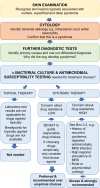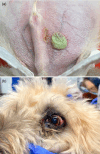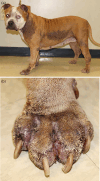Antimicrobial use guidelines for canine pyoderma by the International Society for Companion Animal Infectious Diseases (ISCAID)
- PMID: 40338805
- PMCID: PMC12058580
- DOI: 10.1111/vde.13342
Antimicrobial use guidelines for canine pyoderma by the International Society for Companion Animal Infectious Diseases (ISCAID)
Abstract
Background: Canine pyoderma is one of the most common presentations in small animal practice, frequently leading to antimicrobial prescribing.
Objectives: To provide clinicians with antimicrobial treatment guidelines for staphylococcal pyoderma, including those involving meticillin-resistant staphylococci. Guidance on diagnosing surface, superficial and deep pyoderma and their underlying primary causes, is included. Recommendations aim to optimise treatment outcomes while promoting responsible antimicrobial use.
Materials and methods: Evidence was gathered from a systematic literature review of English-language treatment studies for canine pyoderma up to 23 December 2023. Quality was assessed using SORT criteria and combined with authors' consensus evaluation. Recommendations were voted on in an iterative process, followed by a Delphi-style feedback process before final agreement by the authors.
Results: Cytology should be performed in all cases before antimicrobials are used. Topical antimicrobial therapy alone is the treatment-of-choice for surface and superficial pyodermas. Systemic antimicrobials should be reserved for deep pyoderma and for superficial pyoderma when topical therapy is not effective. Systemic therapy, with adjunctive topical treatment, is initially provided for 2 weeks in superficial and 3 weeks in deep pyoderma, followed by re-examination to assess progress and manage primary causes. First-choice drugs have expected efficacy against the majority of meticillin-susceptible Staphylococcus pseudintermedius; for all other drugs, laboratory testing should confirm susceptibility and exclude suitability of safer alternatives. As culture and susceptibility testing are essential for rationalising systemic therapy, laboratories and practices should price them reasonably to encourage use. Proactive topical therapy using antiseptics may help prevent recurrences.
Conclusions and clinical relevance: The accessibility of the skin offers excellent, achievable opportunities for antimicrobial stewardship.
Hintergrund: Die canine Pyodermie ist eine der häufigsten Vorstellungen in der Kleintierpraxis, was häufig zu einer Verschreibung von Antibiotika führt.
Ziele: Das Ziel war es, KlinikerInnen mit antimikrobiellen Richtlinien für die Staphylokokken Pyodermie auszustatten, inklusive jener mit Methicillin‐resistenten Staphylokokken. Eine Anleitung zur Diagnose von Oberflächen‐, oberflächlicher und tiefer Pyodermie, sowie die zugrundeliegenden Primärursachen sind inkludiert. Die Empfehlungen zielen darauf ab, die Behandlungserfolge zu optimieren, während ein verantwortungsbewusster Einsatz von Antibiotika erfolgt.
Materialien und methoden: Die Evidenz wurde aus einer systematischen Literatur Review aus Behandlungsstudien in englischer Sprache für canine Pyodermie bis zum 23/12/2023 zusammengesucht. Die Qualität wurde mittels SORT‐Kriterien erfasst und mit der Konsensus Evaluierung der Autoren kombiniert. Über die Empfehlungen wurde in einem schrittweisen Prozess abgestimmt, gefolgt von einem Delphi‐Stil Feedback Prozess vor einer endgültigen Übereinstimmung durch die Autoren.
Ergebnisse: Eine Zytologie sollte in allen Fällen, bei denen Antibiotika eingesetzt werden, durchgeführt werden. Eine alleinige topische Therapie ist die Behandlung der Wahl für Oberflächen‐ und oberflächliche Pyodermie. Systemische Antibiotika sollten für tiefe Pyodermien reserviert werden oder für oberflächliche Pyodermien, bei denen die topische Therapie alleine nicht wirksam ist. Eine systemische Therapie mit zusätzlicher topischer Therapie wird anfangs für 2 Wochen bei oberflächlicher und 3 Wochen bei tiefer Pyodermie eingesetzt, gefolgt von einer neuerlichen Untersuchung, um den Fortschritt zu erfassen und primäre Fälle zu managen. Mittel der ersten Wahl haben erwartungsgemäß eine Wirksamkeit gegenüber der Mehrheit der Methicillin‐empfindlichen Staphylococcus pseudintermedius; für alle anderen sollte ein Labortest die Empfindlichkeit bestätigen und die Einsatzmöglichkeit sicherer Alternativen dadurch ausgeschlossen sein. Da Bakterienkultur und Antibiogramm essenziell sind, um eine systemische Therapie zu vertreten, sollten diese von Labors und Praxen zu vernünftigen Preisen angeboten werden, um ihren Einsatz zu unterstützen. Eine proaktive topische Therapie mittels Antiseptika könnte helfen, ein Wiederauftreten zu verhindern.
Schlussfolgerungen und klinische bedeutung: Der einfache Zugang zur Haut ermöglicht exzellente, erreichbare Möglichkeiten für antimikrobielle Stewardship.
背景: 犬脓皮病是小动物临床中最常见的病症之一,经常导致抗菌药物的处方使用。 目的: 为临床医生提供犬葡萄球菌性脓皮病(包括耐甲氧西林葡萄球菌感染)的抗菌治疗指南。指南涵盖了表面、浅表和深层脓皮病的诊断及其潜在的原发性病因。推荐意见旨在优化治疗效果的同时,促进负责任的抗菌药物使用。 材料与方法: 通过系统回顾截至2023年12月23日英文文献中关于犬脓皮病治疗的研究来收集证据。质量评估采用SORT标准,并结合作者共识进行评价。推荐意见通过反复投票以及德尔菲式反馈流程完成,最终由作者达成一致。 结果: 在使用抗菌药物之前,应对所有病例进行细胞学检查。对于表面和浅表脓皮病,单独使用外部抗菌治疗是首选治疗方法。全身性抗菌药物应仅用于深层脓皮病以及浅表脓皮病经外部治疗无效时。对于浅表脓皮病,全身性治疗联合外部治疗应先持续2周,对于深层脓皮病则应持续 3 周,之后重新检查以评估疗效并管理原发因素。首选药物通常可对大多数对甲氧西林敏感的假中间型葡萄球菌有效;对于其他情况,应通过实验室检测确认药物敏感性,并排除更安全的替代药物。由于培养和药敏试验对于合理使用全身性抗菌药物至关重要,实验室和诊所应合理定价以鼓励使用。主动使用含有抗菌成分的外用制剂可能有助于预防复发。 结论与临床意义: 皮肤的易接近性为抗菌药物管理提供了极好的、可实现的机会。.
Contexte: La pyodermite canine est l'une des présentations les plus courantes dans la pratique des petits animaux, conduisant fréquemment à la prescription d'antimicrobiens OBJECTIFS: Fournir aux cliniciens des lignes directrices pour le traitement antimicrobien des pyodermites staphylococciques, y compris celles impliquant des staphylocoques résistants à la méticilline. Des conseils sur le diagnostic des pyodermites de surface, superficielles et profondes, ainsi que sur leurs causes primaires sous‐jacentes, sont inclus. Les recommandations visent à optimiser les résultats du traitement tout en promouvant une utilisation responsable des antimicrobiens. MATÉRIELS ET MÉTHODES: Les données ont été recueillies à partir d'une analyse documentaire systématique des études en langue anglaise sur le traitement de la pyodermite canine jusqu'au 23/12/2023. La qualité a été évaluée à l'aide des critères SORT et combinée à l'évaluation consensuelle des auteurs. Les recommandations ont été votées dans le cadre d'un processus itératif, suivi d'un processus de rétroaction de type Delphi avant l'accord final des auteurs. RÉSULTATS: Une cytologie doit être effectuée dans tous les cas avant d'utiliser des antimicrobiens. La thérapie antimicrobienne topique seule est le traitement de choix pour les pyodermites de surface et superficielles. Les antimicrobiens systémiques doivent être réservés aux pyodermites profondes et aux pyodermites superficielles lorsque le traitement topique n'est pas efficace. Le traitement systémique, accompagné d'un traitement topique complémentaire, est administré initialement pendant deux semaines pour les pyodermites superficielles et trois semaines pour les pyodermites profondes, suivi d'un réexamen pour évaluer l'évolution et traiter les causes primaires. Les médicaments de premier choix ont une efficacité attendue contre la majorité des Staphylococcus pseudintermedius sensibles à la méticilline; pour tous les autres, les tests de laboratoire doivent confirmer la sensibilité et exclure la pertinence d'alternatives plus sûres. La culture et l'antibiogramme étant essentiels pour rationaliser le traitement systémique, les laboratoires et les cabinets médicaux doivent les facturer à un prix raisonnable afin d'encourager leur utilisation. Un traitement topique proactif utilisant des antiseptiques peut aider à prévenir les récidives.
Conclusions et pertinence clinique: L'accessibilité de la peau offre d'excellentes possibilités, réalisables, de gestion des antimicrobiens.
背景: 犬の膿皮症は小動物臨床において最も一般的な疾患の一つであり、しばしば抗菌薬の処方につながる。 目的: 本報告の目的は、メチシリン耐性ブドウ球菌を含むブドウ球菌性膿皮症に対する抗菌薬治療のガイドラインを臨床医に提供することである。表面性膿皮症、表在性膿皮症、深在性膿皮症、およびそれらの根本的な主原因の診断に関するガイダンスを含む。推奨事項は、責任ある抗菌薬使用を促進しながら治療成績を最適化することを目的としている。 材料と方法: 2023年12月23日までの犬の膿皮症に関する英語による治療研究の系統的文献レビューからエビデンスを収集した。SORT基準を用いて質を評価し、著者のコンセンサス評価と組み合わせた。推奨は、著者による最終的な合意の前に、デルフィ式フィードバックプロセスを経て、反復プロセスで投票された。 結果: 抗菌薬を使用する前に、すべての症例で細胞診を行うべきである。表面および表在性の膿皮症に対しては、局所抗菌薬療法のみを選択すべきである。抗菌薬の全身投与は、深在性膿皮症および局所療法が無効な場合の表在性膿皮症にのみ行う。全身療法と補助的な局所療法は、まず表在性膿皮症では2週間、深在性膿皮症では3週間行い、その後、経過を評価し、主原因を管理するために再検査を行う。第一選択薬は、メチシリン感受性Staphylococcus pseudintermediusの大部分に対して有効である。細菌培養検査および薬剤感受性検査は全身療法の合理化に不可欠であるため、検査施設および診療所は適正な価格を設定して使用を奨励すべきである。殺菌薬を用いた積極的な局所療法は再発予防に役立つであろう。 結論と臨床的意義: 皮膚へのアクセスが容易であるため、抗菌薬管理に対する、優れた、達成可能な機会を提供する。.
Contexto: A piodermite canina é uma das apresentações mais comuns na clínica de pequenos animais, frequentemente levando à prescrição de antimicrobianos.
Objetivos: Fornecer aos clínicos diretrizes de tratamento antimicrobiano para piodermite estafilocócica, incluindo aquelas envolvendo estafilococos resistentes à meticilina. Orientações sobre o diagnóstico de piodermite de superfície, profunda e superficial, e suas causas primárias subjacentes, estão incluídas. As recomendações visam otimizar os resultados do tratamento, ao mesmo tempo em que promovem o uso responsável de antimicrobianos. MATERIAIS E MÉTODOS: As evidências foram coletadas de uma revisão sistemática da literatura de estudos de tratamento para piodermite canina escritos em inglês até 23/12/2023. A qualidade foi avaliada utilizando os critérios SORT e combinada com a avaliação de consenso dos autores. As recomendações foram votadas em um processo iterativo, seguido por um processo de feedback no estilo Delphi antes do acordo final pelos autores.
Resultados: A citologia deve ser realizada em todos os casos antes que os antimicrobianos sejam utilizados. A terapia antimicrobiana tópica sozinha é o tratamento de escolha para piodermites de superfície e superficiais. Antimicrobianos sistêmicos devem ser reservados para piodermites profundas e para piodermites superficiais quando a terapia tópica não for eficaz. A terapia sistêmica, com tratamento tópico adjuvante, é inicialmente fornecida por 2 semanas em piodermites superficiais e 3 semanas em piodermites profundas, seguida de reexame para avaliar o progresso e controlar as causas primárias. Os medicamentos de primeira escolha têm eficácia esperada contra a maioria dos Staphylococcus pseudintermedius suscetíveis à meticilina; para todos os outros, os testes laboratoriais devem confirmar a suscetibilidade e excluir a possibilidade de uso de alternativas mais seguras. Como os testes de cultura e suscetibilidade são essenciais para o uso racional da terapia sistêmica, os laboratórios e as clínicas devem precificá‐los razoavelmente para incentivar o seu uso. A terapia tópica proativa usando antissépticos pode ajudar a prevenir recorrências. CONCLUSÕES E RELEVÂNCIA CLÍNICA: A acessibilidade da pele oferece excelentes oportunidades viáveis para a administração antimicrobiana.
INTRODUCCIÓN: La pioderma canina es una de las presentaciones más comunes en la práctica clínica de pequeños animales, lo que frecuentemente conlleva la prescripción de antimicrobianos. OBJETIVOS: Proporcionar a los profesionales clínicos pautas de tratamiento antimicrobiano para la pioderma estafilocócica, incluyendo aquellas que involucran estafilococos resistentes a la meticilina. Se incluye orientación sobre el diagnóstico de pioderma externa, superficial y profunda, y sus causas primarias subyacentes. Las recomendaciones buscan optimizar los resultados del tratamiento, promoviendo al mismo tiempo el uso responsible de antimicrobianos. MATERIALES Y MÉTODOS: La evidencia se obtuvo de una revisión sistemática de la literatura sobre estudios de tratamiento de pioderma canina en inglés hasta el 23/12/2023. La calidad se evaluó mediante los criterios SORT y se combinó con la evaluación por consenso de los autores. Las recomendaciones se votaron mediante un proceso iterativo, seguido de un proceso de retroalimentación tipo Delphi antes de la aprobación final por parte de los autores. RESULTADOS: Se debe realizar una citología en todos los casos antes de utilizar antimicrobianos. La terapia antimicrobiana tópica por sí sola es el tratamiento de elección para las piodermas externas y superficiales. Los antimicrobianos sistémicos deben reservarse para las piodermas profundas y para las piodermas superficiales cuando la terapia tópica no es efectiva. La terapia sistémica, con tratamiento tópico adyuvante, se administra inicialmente durante 2 semanas en las piodermas superficiales y 3 semanas en las profundas, seguida de una reevaluación para evaluar la evolución y abordar las causas primarias. Los fármacos de primera elección tienen la eficacia esperada contra la mayoría de los Staphylococcus pseudintermedius sensibles a la meticilina; para todos los demás, las pruebas de laboratorio deben confirmar la sensibilidad y descartar la idoneidad de alternativas más seguras. Dado que el cultivo y las pruebas de sensibilidad son esenciales para racionalizar la terapia sistémica, los laboratorios y las clínicas deben fijar un precio razonable para fomentar su uso. La terapia tópica proactiva con antisépticos puede ayudar a prevenir las recurrencias. CONCLUSIONES Y RELEVANCIA CLÍNICA: La accesibilidad de la piel ofrece excelentes oportunidades para la optimización del uso de antimicrobianos.
© 2025 The Author(s). Veterinary Dermatology published by John Wiley & Sons Ltd on behalf of ESVD and ACVD.
Conflict of interest statement
None of the authors have received any financial contribution for the guideline project.
Figures









References
-
- Hughes LA, Williams N, Clegg P, Callaby R, Nuttall T, Coyne K, et al. Cross‐sectional survey of antimicrobial prescribing patterns in UK small animal veterinary practice. Prev Vet Med. 2012;104:309–316. - PubMed
-
- Miller WH, Griffin CE, Campbell KL. Muller and Kirk's small animal dermatology, 7th edition. St Louis, MO: Elsevier Mosby; 2013. p. 184–222.
-
- Sykes J. Bacterial diseases. Section 2. In: Sykes JE, Rankin SC, Papich MG, Weese JS, Little SE, editors. Greene's infectious diseases of the dog and cat. 5th ed. St. Louis, Missouri: Elsevier; 2022. p. 522–548.
-
- Faccin M, Wiener DJ, Rech RR, Santoro D, Rodrigues Hoffmann A. Common superficial and deep cutaneous bacterial infections in domestic animals: a review. Vet Pathol. 2023;60:796–811. - PubMed
-
- Hillier A, Lloyd DH, Weese JS, Blondeau JM, Boothe D, Breitschwerdt E, et al. Guidelines for the diagnosis and antimicrobial therapy of canine superficial bacterial folliculitis (antimicrobial guidelines working Group of the International Society for Companion Animal Infectious Diseases). Vet Dermatol. 2014;25:163‐e43. - PubMed
Publication types
MeSH terms
Substances
LinkOut - more resources
Full Text Sources
Medical
Research Materials

